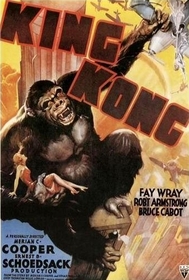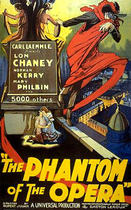Our editor-in-chief Nate Yapp is proud to have contributed to the new book Hidden Horror: A Celebration of 101 Underrated and Overlooked Fright Flicks, edited by Aaron Christensen. Another contributors include Anthony Timpone, B.J. Colangelo, Dave Alexander, Classic-Horror.com's own Robert C. Ring and John W. Bowen. Pick up a copy today from Amazon.com!
King Kong (1933)
King Kong is like Moby Dick. Enormous animal theme aside, it’s one of those old great works that everyone knows about but that not many have actually seen for themselves. It has become such a household name that relatively few people seem to truly care about it anymore. They know the concept, so for some reason they don’t care to experience the film firsthand, or worse: they’ve seen a remake, so they accept it as a surrogate. Peter Jackson’s remake did do a noble job of retelling the story, but, as the cliché goes, there’s just nothing like the original, and I’m sure Jackson would agree with that.
The actual story of King Kong is simple. Carl Denham, a filmmaker, is leading a large crew to an undisclosed (and largely undiscovered) island to make his next moving picture. No one knows why he’s so secretive about it or why, when filming footage on the boat, he directs his actress, Ann Darrow, to look up and scream out of terror. In the story, we have just enough to give us what we need to get to our journey to Skull Island and experience the events of the adventure. When the island is found, Kong takes Darrow for himself, and the crew sets out to rescue her in an undertaking that results in the grizzly deaths of twelve of them, according to Denham’s count (not including natives), and the eventual capture of the beast. As any vaguely aware member of our culture knows, that is only the beginning of the problems caused by Kong.
The stop-motion photographic effects are the film’s greatest, though not only, virtue, thanks to Willis O’Brien, who pioneered the methods used. The beauty and the beast theme is important, but, as the opening Arabian proverb proves, it is not entirely original. Without the effects, the movie would have been nothing, and the painstaking labor involved in creating even the most ordinary movements by Kong and other Skull Island creatures, combined with the believability of the creatures’ movements, makes them that much more impressive. Supposedly, one minute of animation took 150 hours of labor, and the tyrannosaurus fight alone took seven weeks1. Without the patience, diligence, and exactitude that the animators apparently had, we would have ended up with something much more simplistic.
Even viewing the film for the first time, it is easy to see the care taken in the animation throughout (though I recommend at least two viewings to really take it all in). Each little movement conveys not only an action but also an emotion. These details are what make the movie, and they are what make Kong a living character. It could have been about a gorilla smashing things and killing people, but everything is taken one, two, three steps further. The stop motion is not just done well—it is done consistently superbly. When we see Kong raising his eyebrows and smiling at the sight of Darrow, we know he is in love. When the tyrannosaurus scratches his face, we believe he really itches. And that famous fight between Kong and the T-rex is a masterpiece itself. The fight is brutal even by today’s standards, and when we see the T-rex sliding his tail back and forth while Kong is on the ground, it is clear he just wants him to get back up and fight. Then, when Kong finally wins, he does something that was truly a stroke of genius by the animators. This is just one scene, of course, but it is representative of the care taken throughout the entire film.
King Kong is marked with strong characterization, also. Kong’s character is topped with a good bit of violence to add one more level of believability. Sure, he is misunderstood, but that doesn’t mean he’s perfect. Kong kills a lot of people in some bad ways. And while he is certainly the greatest character, the real actors also do a great job for the most part. Fay Wray balances perfectly on naïveté without falling into the realm of dumb, as most actors would. We empathize with her instead of scoffing at her. The Denham character is great, too. He is indeed something of a scoundrel, but he is also likeable and even funny. I suspect many of those who criticized the placement of Jack Black in this role in Jackson’s remake had forgotten this. The character is a little deceptive but is somehow honest about it. When he meets Darrow, for instance, he tells her, “Don’t fool yourself. I’m not bothering about you just out of kindness.” He won’t tell his crew what to expect, but he doesn’t actually lie to them either. The ship’s first mate, Jack Driscoll, is the only character that isn’t entirely believable. He makes an essential change from lumberjack to man in love, but it happens a little too fast. This is more a flaw of the film’s pacing than of the acting itself, though, and it is a small one.
As I stated, the beauty and the beast theme, though not the driving force of the movie, is nonetheless an important part of it. It is a classic theme, but has never been portrayed so wonderfully, thanks not only to the fully realized Kong but to the perfectly cast Wray as well. The theme is used on multiple levels, too, including the love affair between Darrow and Driscoll. At first he is a Han Solo of the sea, but he softens after only a few conversations with her. In this light, Kong’s death could be a sort of metaphor for Driscoll’s fate.
This is also a movie about making movies. More specifically, and confusedly, this movie is about itself in a way, and as such, its success can tell us something about ourselves. Denham, whose character is based on co-director Merian C. Cooper himself, is seeking out Kong purely to make him into the world’s greatest moving picture, and that is what King Kong essentially became at the time. Kong, then, can also symbolize the movie itself. And the symbolism holds up, depending on how you look at it. Kong dies, but surely will never be forgotten. In the same way, this movie has sunk into our culture’s mythology (which is why it lends itself to remakes). It has lost the immediacy it once had, but it lives on in a spot in our subconscious, a spot that was just dying for a giant gorilla climbing the Empire State Building with damsel in hand, just like any good capitalist would. This is a cultural connection that few films can match. This connection makes the ending that much more tragic. When Kong battles the planes, we cheer for him, but we know he has to lose.
One of the outstanding things about King Kong is that it truly and successfully has something for everyone. It has at least a little bit of everything—action, adventure, horror, sci-fi, drama, love, even humor—and they somehow combine well despite the disparity. There are many great films about which we would say, “In the hands of another director, this would never have worked.” King Kong is the opposite. The movie has such raw power that it would have succeeded in anyone’s hands, but co-directors Cooper and Ernest B. Schoedsack, and special effects guru O’Brien were the only ones actually capable of making it at all. There are few films that everyone should see, but this is one of them.
1RKO Production 601: The Making of Kong, Eighth Wonder of the World. King Kong (Two-disc Collector’s Edition). Turner Entertainment. 2005.









I have a steel metal sign of
I have a steel metal sign of the above picture (top right of this page). Do you know what it might be worth or where I can look to find out more information about it?
No idea. There's a good
No idea. There's a good chance it's just a reproduction of the original sign (I don't think they did much steel sign advertising back then -- but I don't know much about the topic). If that's the case, it's probably not worth any more than any other steel poster/sign.
I have the same movie tin
I have the same movie tin poster of the 1933 King Kong film. Just by looking at mine, it doesnt appear to be a reproduction and it has RKO trademark on the sign along with the copyright and date on the back of the metal sign. I would definitely like to know if it worth anything.
I remember becoming strangely
I remember becoming strangely aroused when Kong crushed the jaws of the T-Rex as a kid.